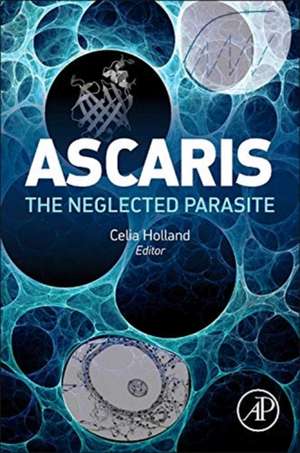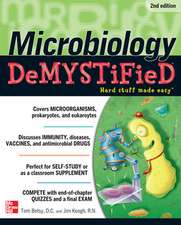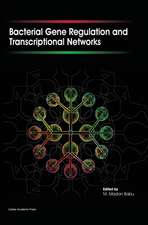Ascaris: The Neglected Parasite
Editat de Celia Hollanden Limba Engleză Hardback – aug 2013
- Brings together a wide range of topics and approaches and recent, comprehensive and progressive research concerning the neglected parasite Ascaris
- Provides a blueprint of how a single parasite entity can stimulate interest in basic biology, clinical science, veterinary science, public health and epidemiology
- Presents a wealth of new insights given that a book on this parasite has not been published for over 20 years
- 16 chapters from a range of top authors from around the world
Preț: 642.35 lei
Preț vechi: 855.62 lei
-25% Nou
Puncte Express: 964
Preț estimativ în valută:
122.93€ • 133.48$ • 103.26£
122.93€ • 133.48$ • 103.26£
Carte tipărită la comandă
Livrare economică 15-29 aprilie
Preluare comenzi: 021 569.72.76
Specificații
ISBN-13: 9780123969781
ISBN-10: 0123969786
Pagini: 460
Dimensiuni: 152 x 229 x 28 mm
Greutate: 0.88 kg
Editura: ELSEVIER SCIENCE
ISBN-10: 0123969786
Pagini: 460
Dimensiuni: 152 x 229 x 28 mm
Greutate: 0.88 kg
Editura: ELSEVIER SCIENCE
Public țintă
advanced researchers and students in helminthology, parasitology, epidemiology, molecular and immunological biology. Parasitologists and life scientists working on nematode parasites, veterinary surgeons, veterinary parasitologists, clinicians interested in human parasitology and human health, epidemiologists, World Health professionals.Cuprins
Section I: Biology of Ascaris
1. Immunology of Ascaris and immunomodulation
2. Ascaris and allergy
3. The significance of ABA-1
4. Implications of co-infection with Ascaris
Section II: Model systems
5. The use of the mouse model to explore the role of the liver in susceptibility and resistance to Ascaris
6. Unique attributes of Ascaris as a model system: Neurobiology
Section III: Epidemiology of ascariasis
7. Ascaris lumbricoides: new epidemiological insights and mathematical approaches
8. Genetic epidemiology of Ascaris
9. Mathematical Modeling
Section IV. Host and parasite genetics
10. New insights into evolutionary-history and phylogeography of Ascaris
11. Ascaris genomics
12. Human host susceptibility to ascariasis
Section V. Clinical aspects and public health
13. The extent of the problem: numbers and impact (Ascaris lumbricoides)
14. Impact of Ascaris suum in livestock
15. Approaches to control of STHs including ascariasis
16. Diagnosis and control of Ascaris suum
1. Immunology of Ascaris and immunomodulation
2. Ascaris and allergy
3. The significance of ABA-1
4. Implications of co-infection with Ascaris
Section II: Model systems
5. The use of the mouse model to explore the role of the liver in susceptibility and resistance to Ascaris
6. Unique attributes of Ascaris as a model system: Neurobiology
Section III: Epidemiology of ascariasis
7. Ascaris lumbricoides: new epidemiological insights and mathematical approaches
8. Genetic epidemiology of Ascaris
9. Mathematical Modeling
Section IV. Host and parasite genetics
10. New insights into evolutionary-history and phylogeography of Ascaris
11. Ascaris genomics
12. Human host susceptibility to ascariasis
Section V. Clinical aspects and public health
13. The extent of the problem: numbers and impact (Ascaris lumbricoides)
14. Impact of Ascaris suum in livestock
15. Approaches to control of STHs including ascariasis
16. Diagnosis and control of Ascaris suum
Recenzii
"The publication of this book is…very welcome, with its aim to highlight this state of affairs and to stimulate interest in this much neglected parasite…this volume can be highly recommended to all with an interest in parasitic nematode infection and neglected tropical diseases. It is both an excellent summary of the current state of knowledge of Ascaris infection, and a very useful resource for those studying other parasites." --Parasites & Vectors, January 17, 2014
"Ascaris lumbricoides is a parasitic nematode worm that primarily infects children in impoverished conditions throughout the tropics. As many as 1.2 billion people may be infected. It causes both developmental and cognitive problems in the infected. In spite of being such a common affliction Ascaris remains little studied. This volume of essays…attempts to address that." --Reference & Research Book News, December 2013
"Ascaris lumbricoides is a parasitic nematode worm that primarily infects children in impoverished conditions throughout the tropics. As many as 1.2 billion people may be infected. It causes both developmental and cognitive problems in the infected. In spite of being such a common affliction Ascaris remains little studied. This volume of essays…attempts to address that." --Reference & Research Book News, December 2013









